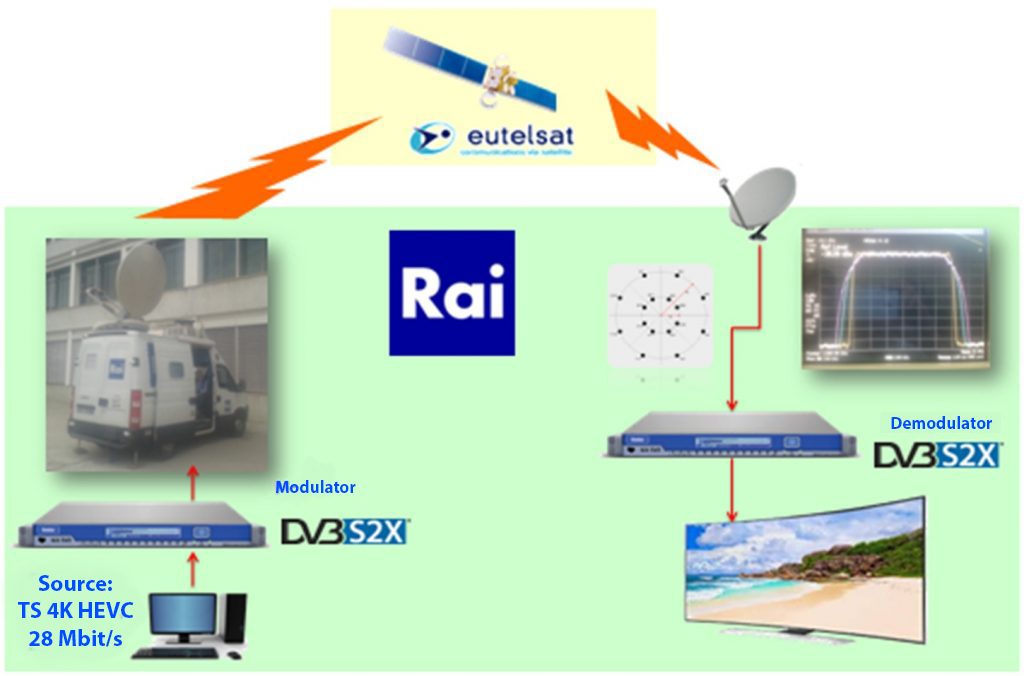DVB-S2X – the DVB-S2 extension for the future of satellite communications
First 4k HEVC satellite transmission using DVB-S2X from Turin
In January 2014 the Steering Board of DVB approved DVB-S2X, the extension of the DVB-S2 specification that will be published as ETSI EN 302 307 part 2, with DVB-S2 being part 1. S2X offers improved performance and features for the core applications of DVB-S2, including Direct to Home (DTH), contribution, VSAT and DSNG. The specification also provides an extended operational range to cover emerging segments such as mobile applications (airplanes, trains, ships, etc.).

DVB-S2X is based on the well-established DVB-S2 specification and introduces the new elements both at the physical layer (a finer gradation and extension of number of modulation and coding modes, new constellation options for linear and non-linear channels smaller roll-off options, additional scrambling options for critical co-channel interference situations) and at the higher layers (Channel bonding, GSE and GSE-Lite protocols, Super-frame option).
DVB-S2 already offered excellent spectral efficiency for DTH applications and S2X therefore could not produce physical layer gains comparable to the transition from DVB-S to S2 (i.e. around 30%). Nevertheless, for DTH DVBS2X fine-tunes both the physical and the upper protocol layers of DVB-S2, producing a highly attractive package (for new generation services, which would require new receivers in any case). For Professional and DSNG applications high efficiency modulation schemes allow spectral efficiencies approaching 6 bps/Hz (with 256APSK). C/N values of up to 20 dB are now supported with an achievable gain improvement of up to 50%.
On October 21, 2014 a DVB-S2X signal containing a 4k UHDTV bouquet has been transmitted for the first time from Rai-CRIT premises, on Eutelsat 5W satellite, using 16APSK26/45 and 5% roll-off, and 17Mbaud on 18 MHz bandwidth, offering about 41,8Mbit/s capacity.
The chosen configuration, 16APSK with error correction (FEC) code rate 26/45 allows for a spectral efficiency of 2.46 bit/s/Hz. The roll-off used was of 5%. With an available bandwith of 18MHz, we adopted a symbol rate of 17 Mb, thus achieving 41.8 Mbps capacity. The satellite transmission has been done on the satellite transponder Eutelsat 5W, KB11. This satellite has for Turin 6 dB G/T and 53 dBW EIRP. The reception was made in Turin with a 90 cm dish, getting receive margin measured about 6dB, in good agreement with the calculated link budget.
More information
Authors:
Daniele Airola, Andrea Bertella, Fulvio Bonacossa, Vittoria Mignone, Bruno Sacco, Mirto Tabone, Michele Visintin.
Collaborations:
This activity was carried out as part of a collaboration between Rai-CRIT and Eutelsat.
References
- Morello, V. Mignone, “Il sistema DVB-S2 di seconda generazione per la trasmissione via satellite e Unicast”, Elettronica e Telecomunicazioni, Anno LII, n°3, Dicembre 2003, http://www.crit.rai.it/eletel/2003-3/33-1.pdf
- ETSI EN 302 307-2, “DVB, Second generation framing structure, channel coding and modulation systems for Broadcasting, Interactive Services, News Gathering and other broadband satellite applications; Part 2; DVB-S2 extensions (DVB-S2X)”.
- ETSI TR 102376-2: “Digital Video Broadcasting (DVB); Implementation guidelines for the second generation system for Broadcasting, Interactive Services, News Gathering and other broadband satellite applications; Part II : S2 eXtensions“.
- Vittoria Mignone, Alberto Morello, Giovanni Vitale, “DVB-S2X: l’estensione verso il futuro delle comunicazioni via satellite”, Elettronica&Telecomunicazioni, Anno LXIII – Numero 1/2014, http://www.crit.rai.it/eletel/2014-1/141-2.pdf
- ETSI EN 302 307-1, “DVB, Second generation framing structure, channel coding and modulation systems for Broadcasting, Interactive Services, News Gathering and other broadband satellite applications – Part 1; DVB-S2”
- Daniele Airola Gnota, Andrea Bertella, Fulvio Bonacossa, Vittoria Mignone, Bruno Sacco, Mirto Tabone e Michele Visintin, “Il DVB-S2X in onda da Torino“, Elettronica & Telecomunicazioni, Anno LXIV – Numero 1/2015, http://www.crit.rai.it/eletel/2015-1/151-4.pdf
Related Projects

Progetto attivo dal 2018
Early Warning System: an innovative system for satellite DTH transmission of alarm signals embedded in DVB-S/S2 signals
A new method to generate and transmit alarm signals to alert the population in the event of natural disasters, embedded in satellite TV transmissions has been devised by Rai-CRITS and proposed to DVB. The prototype developed in the project allowed us to test in the laboratory the effectiveness of the method and the backward compatibility with existing DVB-S/S2 receivers.

Active project
Satellite transmissions beyond S2X
The DVB is currently starting a Commercial Study Mission casting DVB’s Vision for Satellite Broadcasting, looking at the near- and long term, and going beyond classic geostationary satellite constellations, anticipating a successful bringing into use of future low earth orbiting payloads.
Rai-CRIT will participate in these activities, according to its leaderschip role and active participation in the DVB technical module dedicated to satellite transmissions, aiming at evaluating opportunities, times and methods for new standardisation activities.